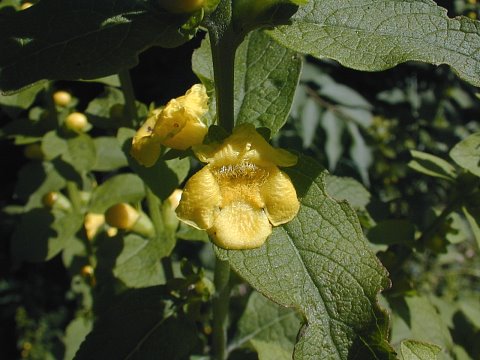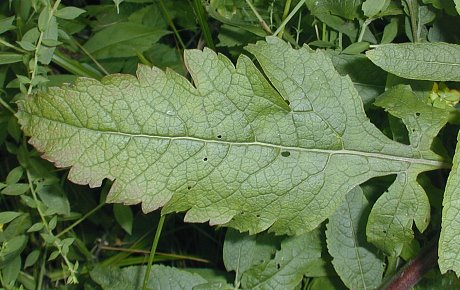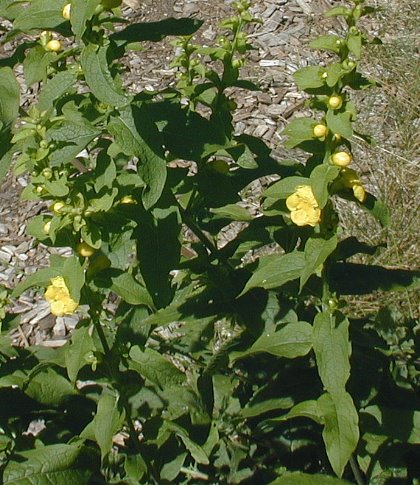Description: This herbaceous plant is a summer annual about 2-6' tall. It branches regularly from the central stem, while the side stems branch very little. These stems are somewhat pubescent and green to reddish green. The opposite leaves are up to 12" and 4" across, becoming smaller as they ascend the stems. The lower leaves are pinnately lobed, cleft, and coarsely toothed, while the upper leaves are lanceolate-oblong and smooth along the margins. The petioles of the leaves become progressively shorter toward the apex of the plant; the upper leaves are often sessile. Both lower and upper leaves are hairless, or nearly so.

The upper stems
terminate in spike-like racemes of yellow flowers. These racemes vary
½–3' in length, depending on the size of the plant. Each flower is
about ½" long, consisting of a yellow tubular corolla with 5 spreading
lobes and a green calyx with 5 blunt teeth. The tubular corolla is
rather short and broad; its throat is partially obstructed by an
abundance of fine yellow hairs. The two upper lobes of the corolla fold
backward, while the 3 lower lobes function as a landing pad for
visiting insects. The blooming period is mid-summer to early fall and
lasts about 1½ months; only a few flowers are in bloom at the same
time. Each flower is replaced by a seed capsule is globoid-ovoid; it
eventually turns brown and contains several seeds. The root system
consists of a taproot and secondary feeder roots. The feeder roots can
attach themselves to the roots of oak trees; they suck moisture and
possibly some nutrients from the host tree. Thus, Mullein Foxglove is
partially parasitic. Reproduction is by seed.
Cultivation:
The preference is partial sun, mesic to dry conditions, and a loam,
clay-loam, or rocky soil. This plant benefits from the proximity of oak
trees. Its size is highly variable, depending on growing conditions.

Range &
Habitat:
The native Mullein Foxglove occurs occasionally throughout most of
Illinois; it is
least common in the NW and south-central areas of the state (see Distribution
Map). Habitats include open rocky woodlands, oak savannas,
paths through woodlands, thinly wooded bluffs, woodland borders,
thickets, and rocky slopes along rivers. This species tolerates low to
moderate levels of disturbance.
Faunal Associations:
The most important pollinators of the flowers are bumblebees, which
suck nectar and collect pollen. Other long-tongued bees also visit the
flowers, including honeybees and Miner bees. Occasionally, butterflies
and skippers suck nectar from the flowers, but they are ineffective
pollinators. The caterpillars of the moth Rhodoecia aurantiago
(Orange Sallow) bore into the seed capsules and feed on the seeds. It
possible that the foliage is eaten by the caterpillars of the
butterflies Junonia coenia (Buckeye) and Euphydryas
phaeton ozarkae (Baltimore). The latter variety of the
Baltimore is confined to southern Illinois. Both of these butterfly
species are known to feed on the foliage of Aureolaria spp.
(False Foxgloves), which are closely related to Mullein Foxglove.

Photographic
Location:
Along a path at Busey Woods in Urbana, Illinois.
Comments:
This annual plant can achieve an impressive size. It closely resembles
several Aureolaria spp. (False Foxgloves), which
are also parasitic on the roots of oaks. The flowers of Mullein
Foxglove are a little shorter than the flowers of the latter species
(which can exceed ¾" in length), and the throat of its flowers are
partially obstructed by an abundance of fine hairs. The flowers of the
False Foxgloves are quite open at the throat because they lack these
hairs. Another scientific name for Mullein Foxglove is Seymeria
macrophylla.